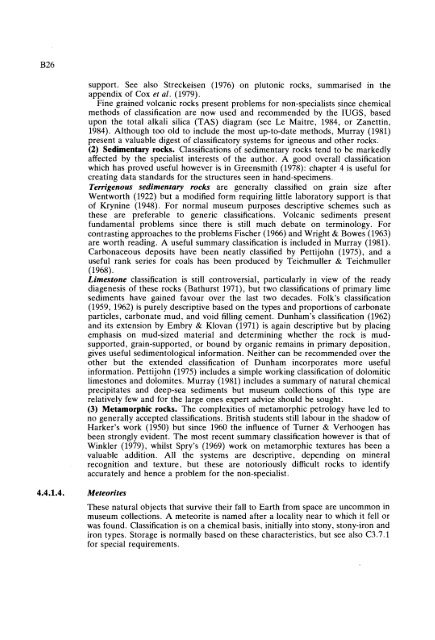GUIDELINES FOR THE CURATION OF GEOLOGICAL MATERIALS
GUIDELINES FOR THE CURATION OF GEOLOGICAL MATERIALS
GUIDELINES FOR THE CURATION OF GEOLOGICAL MATERIALS
You also want an ePaper? Increase the reach of your titles
YUMPU automatically turns print PDFs into web optimized ePapers that Google loves.
4.4.1.4. Meteorites<br />
support. See also Streckeisen (1976) on plutonic rocks, summarised in the<br />
appendix of Cox et al. (1979).<br />
Fine grained volcanic rocks present problems for non-specialists since chemical<br />
methods of classification are now used and recommended by the IUGS, based<br />
upon the total alkali silica (TAS) diagram (see Le Maitre, 1984, or Zanettin,<br />
1984). Although too old to include the most up-to-date methods, Murray (1981)<br />
present a valuable digest of classificatory systems for igneous and other rocks.<br />
(2) Sedimentary rocks. Classifications of sedimentary rocks tend to be markedly<br />
affected by the specialist interests of the author. A good overall classification<br />
which has proved useful however is in Greensmith (1978): chapter 4 is useful for<br />
creating data standards for the structures seen in hand-specimens.<br />
Terrigenous sedimentary rocks are generally classified on grain size after<br />
Wentworth (1922) but a modified form requiring little laboratory support is that<br />
of Krynine (1948). For normal museum purposes descriptive schemes such as<br />
these are preferable to generic classifications. Volcanic sediments present<br />
fundamental problems since there is still much debate on terminology. For<br />
contrasting approaches to the problems Fischer (1966) and Wright & Bowes (1963)<br />
are worth reading. A useful summary classification is included in Murray (1981).<br />
Carbonaceous deposits have been neatly classified by Pettijohn (1975), and a<br />
useful rank series for coals has been produced by Teichmuller & Teichmuller<br />
(1968).<br />
Limestone classification is still controversial, particularly in view of the ready<br />
diagenesis of these rocks (Bathurst 1971), but two classifications of primary lime<br />
sediments have gained favour over the last two decades. Folk's classification<br />
(1959, 1962) is purely descriptive based on the types and proportions of carbonate<br />
particles, carbonate mud, and void filling cement. Dunham's classification (1962)<br />
and its extension by Embry & Klovan (1971) is again descriptive but by placing<br />
emphasis on mud-sized material and determining whether the rock is mudsupported,<br />
grain-supported, or bound by organic remains in primary deposition,<br />
gives useful sedimentological information. Neither can be recommended over the<br />
other but the extended classification of Dunham incorporates more useful<br />
information. Pettijohn (1975) includes a simple working classification of dolomitic<br />
limestones and dolomites. Murray (1981) includes a summary of natural chemical<br />
precipitates and deep-sea sediments but museum collections of this type are<br />
relatively few and for the large ones expert advice should be sought.<br />
(3) Metamorphic rocks. The complexities of metamorphic petrology have led to<br />
no generally accepted classifications. British students still labour in the shadow of<br />
Harker's work (1950) but since 1960 the influence of Turner & Verhoogen has<br />
been strongly evident. The most recent summary classification however is that of<br />
Winkler (1979), whilst Spry's (1969) work on metamorphic textures has been a<br />
valuable addition. All the systems are descriptive, depending on mineral<br />
recognition and texture, but these are notoriously difficult rocks to identify<br />
accurately and hence a problem for the non-specialist.<br />
These natural objects that survive their fall to Earth from space are uncommon in<br />
museum collections. A meteorite is named after a locality near to which it fell or<br />
was found. Classification is on a chemical basis, initially into stony, stony-iron and<br />
iron types. Storage is normally based on these characteristics, but see also C3.7.1<br />
for special requirements.

















